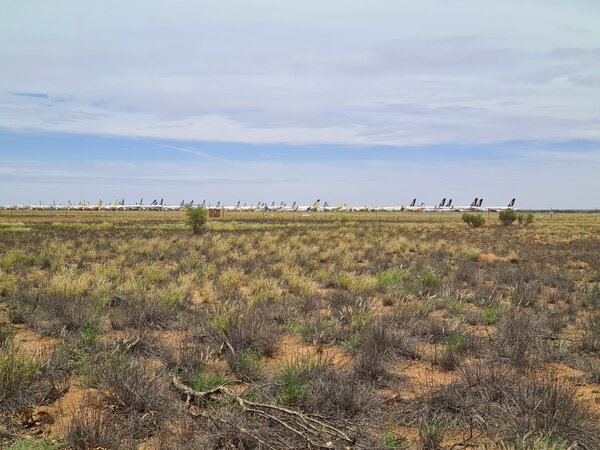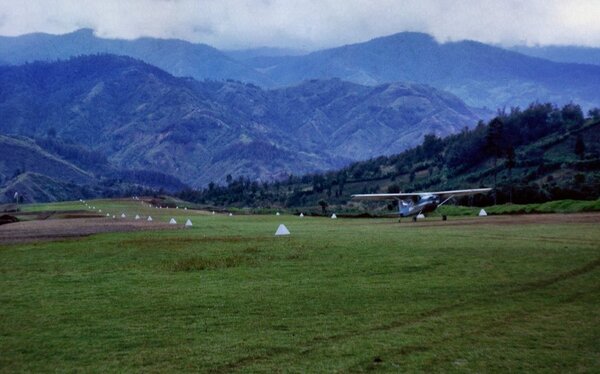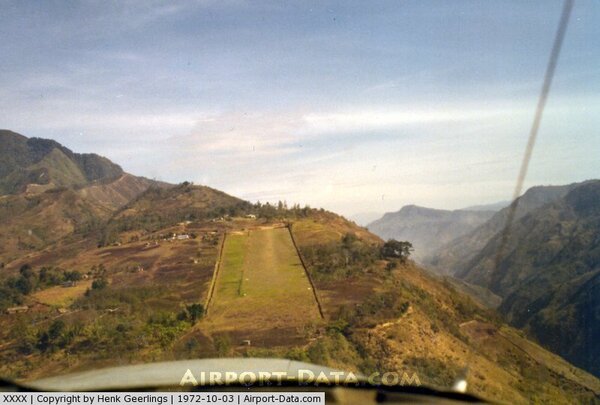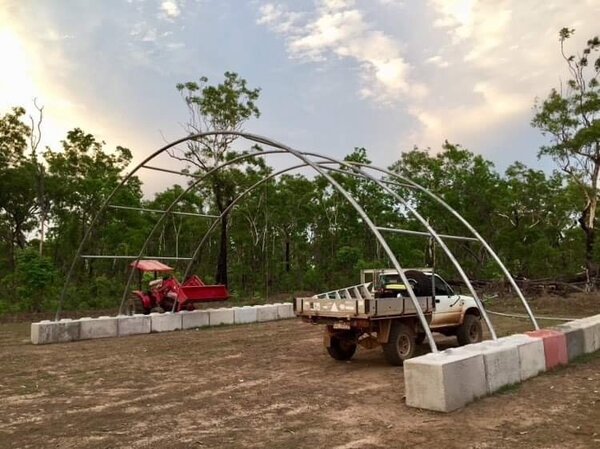-
Posts
476 -
Joined
-
Last visited
-
Days Won
9
Content Type
Profiles
Forums
Gallery
Downloads
Blogs
Events
Store
Aircraft
Resources
Tutorials
Articles
Classifieds
Movies
Books
Community Map
Quizzes
Posts posted by NT5224
-
-
57 minutes ago, onetrack said:
But how do you get Rin-tin-tin to sort out the kangaroos, prior to landing? Drop him off with a parachute, and let him go for it?

Nup
Assuming my wife is at home, I radio ahead. My strip is about a kilometre through thick forest from the house but when the boy is dispatched and Im circling overhead it takes him about three minutes to get there and another two minutes to clear the length of the strip... ( say time it takes me to fly one circuit).
He won't approach an aircraft until the engine shuts down.
He knows his job...
Of course if he's flying with us its more of an issue... Perhaps we should explore the parachute concept...?
🤣
Alan
-
 2
2
-
-
Where I live we have a mob of 30- 50 roos that graze my strip morning and evening when I generally fly. I have therefore developed a highly effective method of clearing the airfield prior to landing or take-off.
Its 100% effective, and this effectiveness does not diminish. It is also humane, as no animals are hurt or unduly frightened by my control method. Here it is:
Alan
-
 7
7
-
 1
1
-
 2
2
-
-
Hey folks
A good question from OP. Even though I now only fly GA I am firmly of the opinion that BFRs are valuable.
My personal experience of BFs in RAA and GA has basically been good. Instructors have been helpful and the process has been beneficial. Particularly somebody like myself, who operates remotely from their own strip rather than In a club environment, spending a couple of hours with an instructor is useful to pull up on any emerging bad habits.
But in the past I have added some additional endorsements to my ticket as a way of achieving BFRs. I believe that there is great value in continuously learning and broadening our knowledge as aviators. We should never stop learning, and so, until somebody comes up with a better way I'm happy to fly BFRs (GA or RAA)
Alan
-
 1
1
-
-
Merry Christmas to all and their loved ones
Lets hope this coming year is better than the current one!
Alan
-
 1
1
-
-
Hi Glen
I said earlier that my new hangar has been built without a concrete floor, exactly along the lines of what Nev has suggested. I would echo this as a genuine alternative to a slab, depending on what and where you are building.
I have built plenty of slabs. My wife and I built our whole home including outbuildings, workshops, sheds and now hangar entirely with our own hands. We have only had outside assistance with electrical wiring and our off grid solar system. All our slabs have been hand mixed and poured on site, because we are too far for a concrete delivery (even with retardant) and at any rate our home site is inaccessible to trucks.
In our experience the key issues are the mixture, quality of cement and materials but most of all the base and screeding.
My wife is an excellent screeder. I personally wouldn't worry to much about polishing unless you're aiming to get onto Grand Designs.
But even then we are now opting for a gravel /metal dust compacted floor. Can't face doing another 144 square metre slab!
But seriously, throwing up a shelter structure isn't a big deal and can be done quite cheaply if you do it yourself. No arcane knowledge required. My wife and myself have hoisted our fabric roofed arched structure
unassisted, with total budget of under $10,000. Would accomodate two C172s comfortably..
Alan
-
I know there are great pics from the air of international airports congested with grounded passenger aircraft, but I've just driven into the Alice airport and had to do a double take as I turned the corner onto the airport access road.
Dozens of aircraft dragged into the scrub and left there. Its quite extraordinary! Not something I expected to see in my lifetime.
Alan
-
 3
3
-
 1
1
-
-
Hi RF guy...I just built out of the dirt. No concrete slab.. but interested to follow this thread for when I hoist a proper hangar
-
All good points Skippy.
A good pilot can fly any configuration of aircraft most places. However as a tailwheel pilot myself based at an outback strip, I consider conventional configuration offers a number of advantages for Bush flying. Possibly tougher undercarriage as you point out, but more important is propeller clearance... There is also something to be said for the angle of attack tail wheel configuration offers.
But hey, the trade off is a really slow cruise and many would feel a faster aircraft better suited to long distance touring... Its just a matter of personal preferences I guess...
Alan
-
 1
1
-
-
I have little doubt that Faeta are excellent aircraft. They look great and so they probably fly great too. We all know the Czechs build good small aircraft.
But the specific question is whether one would make the best touring aircraft for a lap? My personal feeling is that aircraft with bubble canopies are just not climate appropriate in northern Australia. Unless you want to wear a hat and sun cream all way round... Perhaps there is a tropical model with a opaque canopy? Also I would always favour high wing and tail dragger for the bush and rough strips. Thats not to say that low wing trikes are inferior. We are discussing a very specific mission here.
Alan
-
My preference for a LSA tourer would be a Brumby in conventional configuration (taildragger). Metal, tough, tough, and easily repairable and lots of room inside.
Having crossed over to VH now, I think I'd struggle with a 600kg MTOW these days, but if I had to, the Brumby would let me use every kilogram. The J230 is a great aircraft with awesome cruise but for my tour I'd want to be dropping into out of the way places and rough strips, where the Brumby would perform better.
Alan
-
 2
2
-
 1
1
-
-
Hi Shajen! Congrats on the beautiful new bird.
I've gotta ask. Do you now have two Jabirus? Didn't you give us a glimpse of one in your hangar a few months ago?
Cheers
Alan
-
23 hours ago, cscotthendry said:
The weather for video has been great these past few weeks and since the plane is much closer to home, I've been taking advantage of it.
Here's the latest, a wander around our "neighborhood".
Scott
That's a wonderful video! Its a very beautiful neighborhood you have there, and the production quality of the clip was high. Great job!
Three questions:
What's the Legend like to Fly? Its got a whiff of Cessna about its appearance. Does that carry over to flight characteristics? Just a two seater, right? Its a nice looking aircraft.
Second, can you tell us anything about your external camera mount? It seems to work really well.
Finally, do you fly far enough over the soup to need to carry a life raft and buoyancy aids? Or are you staying within glide of the coast? if the former can you tell me about what safety equipment you carry and how much it weighs...
Cheers
Alan
-
Just as we finished the last stages of our home hangar build we decided to move our bird up to MKT and an available hangar space there. Cant wait for the luxury of our own Hangar not having to worry about cramming in with other aircraft, moving things around and the ever present fear of 'hangar rash'. The ferry hop to the coast was pleasant and I just love clear wet season mornings.
-
 6
6
-
-
As said above, for me 'easy to fly' suggests a nice stable airframe with forgiving flight characteristics. That is integral to the aircraft.
'Nice to fly' suggests the both the experience of flying (comfort) and what you can do with an aircraft (performance).
My own aircraft is very easy to fly, extremely stable (some might call it 'boring' in flight). But you have a huge interior, can fly cross-country eight hours ( admittedly at a very slow speed) and can land pretty much anywhere. Its built really tough and solid and you have the advantage of it being a proper
aeroplane with the little wheel at the back...
A 172 is also stable and easy to fly but the overall experience is somehow different
Alan
-
 1
1
-
-
Hi folks
Hope all are staying well. Another question from me which might be more relevant to some of our fraternity than others.
For those of you grounded for any period longer than a few weeks owing to lockdown related restrictions, what has been your experience of returning to flying? What did you do, and how did it go?
Just curious
Alan
-
On 19/11/2020 at 6:33 PM, poteroo said:
Ompkali, Eastern Highlands, PNG (1969) in PA-23-250Turbo C. Twas around 15% and absolutely no go round off final. Over 5000'if I remember. Talair used to fly C402s and Barons into there. Needed near full power to get up the last bit onto the ledge that served as the parking area.
The other frightener was Keglsugl, 8400 amsl and the highest strip in PNG.
Amazing!
-
31 minutes ago, 440032 said:
Flew into a friend's property north of Sunbury, taxied into the back yard and parked near the back door, almost under the hills hoist.
How long/ wide was the strip and what were the surrounding clearances?
Just curious...
-
OK, a whinge from me
The most difficult airstrip I ever landed at was Longreach. About five years ago I was traveling across Australia without an ASIC card. I think I landed at Longreach on a weekend when the place was deserted. It was mid summer, in the mid 40's centigrade and no shade. I had landed to refuel and wait through peak of the heat to avoid midday turbulence. It was extremely hot and I needed avgas and drinking water. I called the relevant authorities, explained my situation and asked permission to leave the apron to because I was becoming dehydrated and needed to drink (there were no water faucets airside). My request for the security gate code was denied.
In the end I got the avgas guy to bring me some a couple of bottles of drinking water with his bowser delivery. That got me to Winton, which in complete contrast was the most wonderful and accommodating airfield I have ever visited. I subsequently wrote to the major and council to thank and commend the caretakers at the airfield for their amazing service.
I still find it hard to believe the authorities would deny a passing pilot drinking water on a blistering day....
Alan
-
 1
1
-
 2
2
-
-
23 hours ago, Blueadventures said:
Looks nice. Re pump I made up a 12 volt one using the red 'AreoFlow' 97 GPH pump works a treat off either the aircraft battery or my hangar spare on a trolley. Cheers
Blue
Good idea. I've admired systems like you describe but to be honest I'm a bit wary of an electric fuel pump owing to fire hazards. I'm out the back of beyond and in the dry season this whole district is a tinderbox waiting for a spark.
The high ambient temperatures here makes batteries temperamental. I'll stick with a basic hand pump for now.
Cheers
Alan
-
 1
1
-
-
21 hours ago, Old Koreelah said:
Alan you have some serious hold-downs there!
Old Korrelah
My father-in-law is a German structural engineer. He calculated we needed 24 tonnes of ballast to hold the structure secure to a sub-cyclonic wind speed. That's 24 tonnes there but the reality is the fabric would give way long before the blocks shifted! Our bird flies south if big winds are expected -and we live outside of the cyclonic zone.
Alan
-
 1
1
-
-
Just a little update on this.
As I mentioned a while back in a discussion about hangars, we are throwing up an arched shade structure for ours. In addition to the basic fabric roof cover we will put up a steel rear wall and a lockable gate on the front.
In case anybody’s wondering, putting up one of these with just two people and a dog beyond the black stump and in blistering temperatures is a bit of a struggle.
Next project will be a little avgas depot with hand pump.
-
 6
6
-
-
As a Top End aviator I must correct Jaba Who. Either he is wrong or I have been conducting my fuel reduction burns at the wrong time for many years..
Fire smoke is a problem for aviators in the north from May until October, our 'Dry season'. You dont hear Northerners talking about 'summer' or 'winter'.
Downunder is on the mark. Turbulence is a huge issue and of course wet season thunderstorms. Early morning flight is most advisable. Fly high enough and those extra couple of degrees make no difference to your engine. But as he says the thermals will ultimately get you and make descent and landing miserable. Temperature in the far north doesnt change much year round, but humidity does so carby icing can also be an issue on descent.
Alan
-
Oh dear. CASA is being reduced down into a bureaucratic soup.
-
Wow! Thanks KR. Thats actually a really good response to another thread I started on here about reasons to maintain a RAA pilot certificate if you fly a VH aircraft. Pretty much all available endorsements will be cheaper with RAA. Even floats.... This could well put financial pressure on GA flight schools.
Alan








SO - Kangaroo's on or near the edge of runway when landing or takeoff. Has anyone tried a horn!!!!
in AUS/NZ General Discussion
Posted
Hi folks.
In my personal experience kangaroo repellers don't work. I've tried a couple (on vehicles not my aircraft!) However, my take on why they don't work is as follows.
Kangaroos are dumb. I absolutely love them, but they are among the dumbest of Gods creatures! When Im out walking the sound of my footsteps through the bush will likely scatter a a big mob when they hear me approaching. However, I can fire a shotgun close to the same mob and they will stand frozen, transfixed by the sound or in some cases even hop forward to investigate.
So the question is not whether roos are hearing the sound emitted (whistle, horn, approaching vehicle or whatever), but how they respond to that sound, and whether it is (from a human perspective) a rational response? Without a much deeper understanding of roo psychology, it is impossible to assume just because a roo hears a particular sound it will respond to it the way a human would.
This is why my own roo control mechanism is the best. Like all good shepherding dogs, The Boy
has learned to intimately understand and predict roo behaviour, and does exactly whats required to shepherd them to safety off the strip. Funnily enough, the roos have also learned about the dog (its the same individuals that come back to the airstrip everyday), and so, like sheep, are not unduly concerned at being shepherded. To them its pretty much part of their daily routine.
Everyones happy.
With respect to fencing the strip, it would cost me approximately $4000 to put a three wire fence round the perimetre. Trouble is, a three wire fence might be useful in sheep country, but wont stop roos as they hop over or push through between the wires. And the occasional buffalo around the property wouldn't even know the fence was there. It would walk straight through, dragging the pickets out behind it. Then Im hit with repair costs. A steel cyclone mesh fence might keep most of the critters out, but as a private individual I can't afford that.
Another consideration is I actually quite like having roos grazing the grass strip, other than when its actually being used for flight operations. I don't want to restrict their access permanently.
Having a good shepherd dog as airstrip guardian is the way to go. Purchase price $2500 and all up about $1000 per year maintenance costs. The airstrip is cleared of critters whenever you want it, and the he keeps an eye on the homestead and hangar too.
And.... I get my face licked at 6.00am every morning.
Result. 🤣
Alan